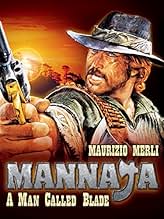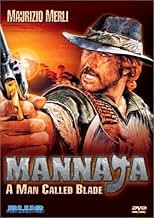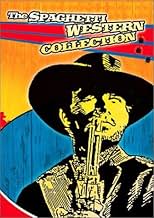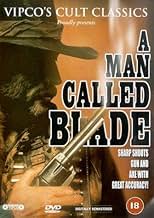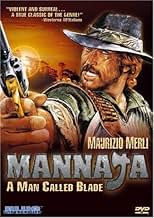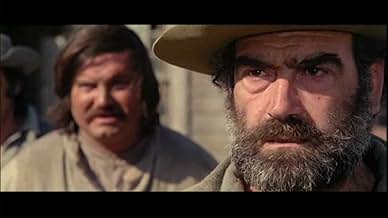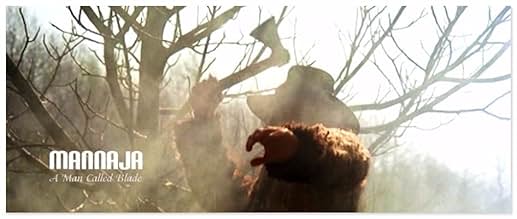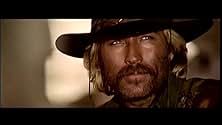IMDb-BEWERTUNG
6,5/10
2120
IHRE BEWERTUNG
Ein Kopfgeldjäger wird vom verkrüppelten Bürgermeister einer Bergbaustadt angeheuert, um seine Tochter zu finden.Ein Kopfgeldjäger wird vom verkrüppelten Bürgermeister einer Bergbaustadt angeheuert, um seine Tochter zu finden.Ein Kopfgeldjäger wird vom verkrüppelten Bürgermeister einer Bergbaustadt angeheuert, um seine Tochter zu finden.
Antonio Casale
- Dahlman
- (as Nino Casale)
Rik Battaglia
- Gerald Merton
- (as Rick Battaglia)
Vincenzo Maggio
- Oldtimer
- (as Enzo Maggio)
Sofia Lombardo
- Lucy Merton
- (as Sophia Lombardo)
Giuseppe Cardone
- Poker player
- (Nicht genannt)
Domenico Cianfriglia
- Valler Henchman
- (Nicht genannt)
Arnaldo Dell'Acqua
- Valler Henchman
- (Nicht genannt)
Ottaviano Dell'Acqua
- Rioting Miner
- (Nicht genannt)
Empfohlene Bewertungen
I found this film to be quite inspirational, actually. The movie is about a man who wields a blade for a weapon in fending off the bad guys while rescuing the girl from the evil villain, Voller (brilliantly played by John Steiner). At the beginning of the film we find our rogue hero Blade (played by Maurizio Merli) chasing after a man through the misty swamps. The man looks behind him frantically several times to try to make out the figure of his pursuer. Suddenly there is a swishing noise in the air as a hatchet blade strikes the man, severing his right hand against a tree. Thus begins the tale, and follows our hero into a virtual ghost town, where "sin and vice are not permitted." He enters a saloon where he and his new companion (the man with the severed hand) receive several shifty-eyed glances. This is when Blade first meets the dastardly Voller and wagers a gamble playing cards, to which of course our hero wins. The filming technique used throughout this scene is truly classic, where some shots show a profile of the villain on one side of the screen, with Blade standing in the background. The character acting is superb. I cannot speak enough about how Steiner personifies the classic old west villain to a "T". His snide mannerisms and long, lean stature lend to his overall character appeal. Throughout this film, there is plenty of splendid gunfighting and even a particularly notable scene in which Blade dukes it out with Voller and three of his henchmen in the mud. Yes, the actor actually does 90% of these stunts (as I later found out watching the director interview on DVD)! The director, Sergio Martino, could not have directed a more well-scripted film, complete with all the elements of a traditional spaghetti western! I give this film 3 out of 4 stars, mainly for its overall character appeal and for the simple fact that it's a 70's flick! 'Nuff said...
I absolutely love this film.
The lead actor, Maurizio Merli, is a handsome man and a decent actor cast in the role of the "Good" Bounty Hunter, with Donald O'Brien as the "Ugly" thief/wanted man, and John Steiner as the "Bad" villain. The acting is top-notch as far as Italian Westerns go. The cinematography is beautiful, the editing great, and the direction superb. The sets are great but shrouded in a mysterious fog that lends to the movies surrealism. This film is like a very Artistic Western Graphic-Novel!
There are a few things in the plot that make you scratch your head (what movie DOESN'T suffer this problem?) but overall I would rank this in my Top Ten Westerns so far...here is the list (only culled from films I have seen thus far)
1. The Good The Bad The Ugly 2. Django 3. Mannaja 4. Fistful of Dollars 5. For a Few Dollars More 6. Tombstone 7. Outlaw Josey Wales 8. Unforgiven 9. Pale Rider 10.Silverado 11.High Plains Drifter 12.Hang Em High 13.Once Upon A Time in the West 14.Fistful of Dynamite 15.The Quick and The Dead
If you are a fan of movies that are as much art as film, then you should love Italian cinema!
The lead actor, Maurizio Merli, is a handsome man and a decent actor cast in the role of the "Good" Bounty Hunter, with Donald O'Brien as the "Ugly" thief/wanted man, and John Steiner as the "Bad" villain. The acting is top-notch as far as Italian Westerns go. The cinematography is beautiful, the editing great, and the direction superb. The sets are great but shrouded in a mysterious fog that lends to the movies surrealism. This film is like a very Artistic Western Graphic-Novel!
There are a few things in the plot that make you scratch your head (what movie DOESN'T suffer this problem?) but overall I would rank this in my Top Ten Westerns so far...here is the list (only culled from films I have seen thus far)
1. The Good The Bad The Ugly 2. Django 3. Mannaja 4. Fistful of Dollars 5. For a Few Dollars More 6. Tombstone 7. Outlaw Josey Wales 8. Unforgiven 9. Pale Rider 10.Silverado 11.High Plains Drifter 12.Hang Em High 13.Once Upon A Time in the West 14.Fistful of Dynamite 15.The Quick and The Dead
If you are a fan of movies that are as much art as film, then you should love Italian cinema!
Eurocrime regular Maurizio Merli headlines this Italian Western about the title bounty hunter, who wields a hatchet rather than a gun. He comes upon the town of Suttonville, which is presided over by a mining boss, McGowan (Philippe Leroy) who supposedly doesn't allow any sort of "sin" or "vice". Mannaja gets caught up in the affairs of the town, going head to head with the crooked and deadly Voller (European exploitation veteran John Steiner) and seeing to some unfinished business that he has with McGowan.
"Mannaja" is directed by Sergio Martino, who was nothing if not versatile, moving from Gialli ("Your Vice is a Locked Room and Only I Have the Key") to post-apocalypse schlock ("2019: After the Fall of New York"), to the cannibal genre ("Mountain of the Cannibal God"). Martino gives the tale some real style, beginning and ending it with very atmospheric sequences. The violence is pretty vicious, but offsetting a certain grimness is a tendency towards levity at times. A case in point: Johnny-Johnny (Salvatore Puntillo) and his dancing girls. The music further adds to the atmosphere, having been composed by Guido and Maurizio De Angelis. Martino gets down to business with an eerie succession of scenes in which outlaw Burt Craven (Donald O'Brien) is pursued by Mannaja.
The charismatic Merli, who does indeed bear a resemblance to the more famous Franco Nero, does a capable job in the lead. He's extremely well supported by Steiner, who looks right at home in this genre; Steiner is a great villain. Leroy, O'Brien, Martine Brochard as dancing girl Angela, and Sonja Jeannine as McGowan's daughter are all fine as well.
Overall, "Mannaja" is pretty good of its type, offering up nice photography, lovely ladies, decent action sequences, a few laughs, and a plot where the hero doesn't always have the upper hand.
Seven out of 10.
"Mannaja" is directed by Sergio Martino, who was nothing if not versatile, moving from Gialli ("Your Vice is a Locked Room and Only I Have the Key") to post-apocalypse schlock ("2019: After the Fall of New York"), to the cannibal genre ("Mountain of the Cannibal God"). Martino gives the tale some real style, beginning and ending it with very atmospheric sequences. The violence is pretty vicious, but offsetting a certain grimness is a tendency towards levity at times. A case in point: Johnny-Johnny (Salvatore Puntillo) and his dancing girls. The music further adds to the atmosphere, having been composed by Guido and Maurizio De Angelis. Martino gets down to business with an eerie succession of scenes in which outlaw Burt Craven (Donald O'Brien) is pursued by Mannaja.
The charismatic Merli, who does indeed bear a resemblance to the more famous Franco Nero, does a capable job in the lead. He's extremely well supported by Steiner, who looks right at home in this genre; Steiner is a great villain. Leroy, O'Brien, Martine Brochard as dancing girl Angela, and Sonja Jeannine as McGowan's daughter are all fine as well.
Overall, "Mannaja" is pretty good of its type, offering up nice photography, lovely ladies, decent action sequences, a few laughs, and a plot where the hero doesn't always have the upper hand.
Seven out of 10.
This film begins with a bounty hunter who goes by the name "Blade" (Maurizio Merli) riding into the small mining town of Suttonville with a criminal named "Burt Craven" (Donald O'Brien) as his prisoner. Unfortunately, when he gets there he is informed that there is no real sheriff there which makes it impossible for him to claim the bounty. To make things even worse, he is also told that the entire town is essentially owned by the wealthy owner of the local silver mine named "Edward McGowan" (Philippe Leroy) and that nothing gets done without his approval or that of his chief enforcer and bodyguard by the name of "Voller" (John Steiner) . To that end, when Blade volunteers to help Edward McGowan with a problem he is experiencing with some local bandits, Voller doesn't take it too well and this results in a serious rift between Blade and everyone else-and Voller is not a man to take things lightly. Now rather than reveal any more I will just say that this was an entertaining "Spaghetti Western" which managed to keep my attention pretty much from start-to-finish. Admittedly, I didn't especially care for a couple of the twists and turns taken and the musical score was a bit odd. But even so I liked this film for the most part and I have rated it accordingly. Slightly above average.
By 1977, the spaghetti western was already on its death throes and if I'm not horribly mistaken, Mannaja is the last major release in the genre. These latter day spaghetti westerns are all visibly different from the 67-71 ones in that they tried to push the envelope in different ways. Ironically the vast amount of tired, quickie Django and Sartana clones that sprung in the late 60's weren't the final nail in the coffin. It seems that after westerns like Mannaja the genre had nowhere to go, having explored every nook and cranny of the old west and milked every bit of potential in the process.
Sergio Martino was not a regular spaghetti western director. He made his name through a series of fantastic giallo thrillers in the early 70's (All the Colours of the Dark, The Strange Vice of Mrs. Wardh etc) but he was generally a genre director who dabbled with anything that came his way. As a testament to his talent, he was usually successful, often with stunning results. He had tried his hand on the western once more in the Anthonio De Steffen vehicle Arizona Colt Returns, which was a pleasurable entry but business as usual for the most part. Mannaja is markedly different in that it strives for more. It has ambition and the means to pull it off.
Strangely, Mannaja takes its cue from Enzo G. Castellari's incredible Keoma (or as it was retitled for commercial purposes, Django Rides Again) from one year earlier. Maurizio Merli's Mannaja bears more than a passing resemblance to the dirty and grim looking Keoma played by Franco Nero, there are several beautiful slo-mo shots, a dream-like atmosphere in places, it's quite brutal (a hand is chopped, a woman is whipped, a man gets an axe in his head, old ladies and other innocent bystanders are shot and killed) and the score is very weird by spaghetti western standards and it can be as annoying as Keoma's (although I didn't mind the latter). Just as Keoma, it doesn't shy away from taking risks and luckily it pays off, no least thanks to Martino's skillful directing. There's visual awesomeness to be found throughout the movie. Striking compositions are enhanced by great set design lending a gritty feeling to everything from the dilapidated town to the dirty clothes to the muddy streets. Nature plays a big part in how the movie looks: rain, mud, fog are all used to great effect, the last shootout in the fog adding a surreal, ghost-town quality to it. The look of the first half hour reminded me of Altman's McCabe and Mrs. Miller for some reason, with a dash of Django. It also appears to be very much influenced by the work of Sam Peckinpah, whom Sergio Martino himself cites as an inspiration. Generally it's equal parts gritty and atmospheric and with enough budget to hold everything on the seams.
Maurizio Merli made his name in the Italian movie business by playing violent Dirty Harry-esquire cops in polizioto crime flicks and was quite successful as a genre actor. He can play the mean machine effortlessly and it's a real pleasure to watch him as a badass bounty hunter here. A real shame that he didn't do more westerns and even more so that he passed away 4-5 years after making this one. The rest of the cast all turn in fine performances.
Mannaja might have come during the twilight of the spaghetti western but it's easily one of the best it has to offer. A must-see for fans.
Sergio Martino was not a regular spaghetti western director. He made his name through a series of fantastic giallo thrillers in the early 70's (All the Colours of the Dark, The Strange Vice of Mrs. Wardh etc) but he was generally a genre director who dabbled with anything that came his way. As a testament to his talent, he was usually successful, often with stunning results. He had tried his hand on the western once more in the Anthonio De Steffen vehicle Arizona Colt Returns, which was a pleasurable entry but business as usual for the most part. Mannaja is markedly different in that it strives for more. It has ambition and the means to pull it off.
Strangely, Mannaja takes its cue from Enzo G. Castellari's incredible Keoma (or as it was retitled for commercial purposes, Django Rides Again) from one year earlier. Maurizio Merli's Mannaja bears more than a passing resemblance to the dirty and grim looking Keoma played by Franco Nero, there are several beautiful slo-mo shots, a dream-like atmosphere in places, it's quite brutal (a hand is chopped, a woman is whipped, a man gets an axe in his head, old ladies and other innocent bystanders are shot and killed) and the score is very weird by spaghetti western standards and it can be as annoying as Keoma's (although I didn't mind the latter). Just as Keoma, it doesn't shy away from taking risks and luckily it pays off, no least thanks to Martino's skillful directing. There's visual awesomeness to be found throughout the movie. Striking compositions are enhanced by great set design lending a gritty feeling to everything from the dilapidated town to the dirty clothes to the muddy streets. Nature plays a big part in how the movie looks: rain, mud, fog are all used to great effect, the last shootout in the fog adding a surreal, ghost-town quality to it. The look of the first half hour reminded me of Altman's McCabe and Mrs. Miller for some reason, with a dash of Django. It also appears to be very much influenced by the work of Sam Peckinpah, whom Sergio Martino himself cites as an inspiration. Generally it's equal parts gritty and atmospheric and with enough budget to hold everything on the seams.
Maurizio Merli made his name in the Italian movie business by playing violent Dirty Harry-esquire cops in polizioto crime flicks and was quite successful as a genre actor. He can play the mean machine effortlessly and it's a real pleasure to watch him as a badass bounty hunter here. A real shame that he didn't do more westerns and even more so that he passed away 4-5 years after making this one. The rest of the cast all turn in fine performances.
Mannaja might have come during the twilight of the spaghetti western but it's easily one of the best it has to offer. A must-see for fans.
Wusstest du schon
- WissenswertesThe reason the exteriors have so much fog and smoke was because the filmmakers were trying to hide the fact that the studio, Elios Studio near Rome, needed to be renovated.
- PatzerIn the opening sequence the man captured screams and you can clearly see his modern fillings.
- Alternative VersionenUK versions are cut by 6 secs by the BBFC to remove footage of horsefalls.
- VerbindungenFeatured in The Spaghetti West (2005)
Top-Auswahl
Melde dich zum Bewerten an und greife auf die Watchlist für personalisierte Empfehlungen zu.
Details
- Erscheinungsdatum
- Herkunftsland
- Sprache
- Auch bekannt als
- Das Beil des Todes
- Drehorte
- Campo Imperatore, L'Aquila, Abruzzo, Italien(Stagecoach / Horse Riding Scenes)
- Produktionsfirmen
- Weitere beteiligte Unternehmen bei IMDbPro anzeigen
- Laufzeit1 Stunde 41 Minuten
- Sound-Mix
- Seitenverhältnis
- 2.35 : 1
Zu dieser Seite beitragen
Bearbeitung vorschlagen oder fehlenden Inhalt hinzufügen

